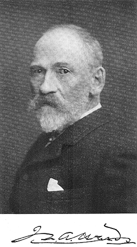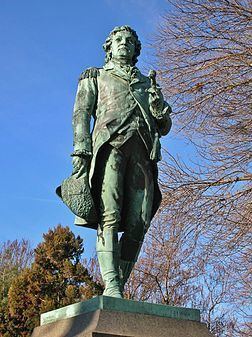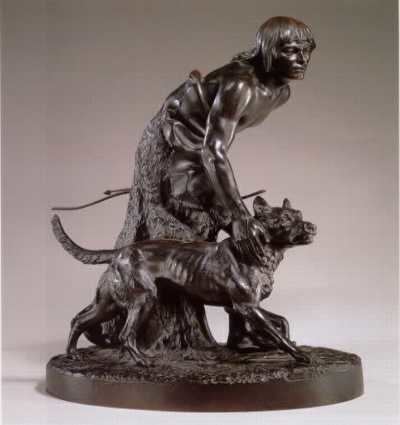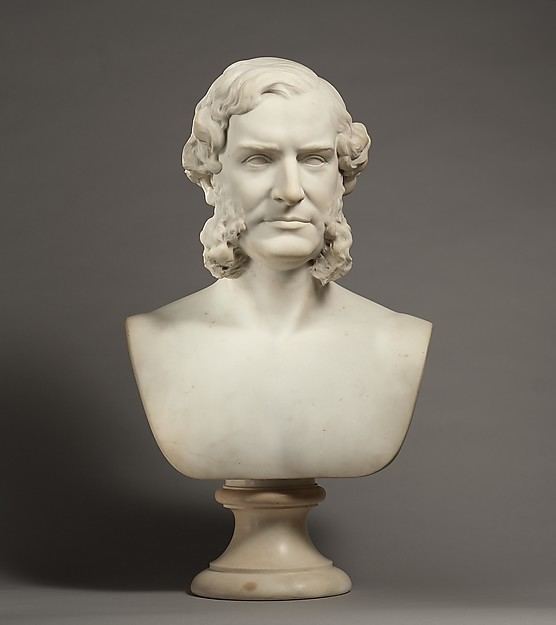Nationality American Siblings Edgar Melville Ward | Period Romanticism Name John Adams | |
 | ||
Full name John Quincy Adams Ward Artwork Indian Hunter, The Freedman, James A Garfield Monument Similar People George Henry Thomas, Thomas Hastings, James A Garfield, George Washington, William Shakespeare | ||
The indian hunter by john quincy adams ward 420 new york historical society
John Quincy Adams Ward (June 29, 1830 – May 1, 1910) was an American sculptor, who may be most familiar for his larger than lifesize standing statue of George Washington on the steps of Federal Hall National Memorial in New York.
Contents
- The indian hunter by john quincy adams ward 420 new york historical society
- John Quincy Adams Ward The Freedman
- Early years
- Career
- Public sculpture
- References

John Quincy Adams Ward, The Freedman
Early years

Ward was the fourth of eight children born to John Anderson Ward and Eleanor Macbeth in Urbana, Ohio, a city founded by his paternal grandfather Colonel William Ward. One of his younger brothers was the artist Edgar Melville Ward. The family lived on William Ward's homestead and 600 acres of land after he died. Growing up, Ward liked to spend his time by the creek-bed fashioning mud into small figures and animals. Ward's interest in three dimensional forms was encouraged by a neighbor and local potter, Miles Chatfield. At the age of 11, Chatfield allowed Ward to have the run of his studio and taught him how to throw a pot and decorate it with bas-reliefs. Ward spent several years working on his family farm, and after seeing a sculpture exhibition in Cincinnati in 1847, felt discouraged from pursuing an artistic career. His family proposed he study medicine, but after contracting malaria, he had to abandon his studies.

Ward later lived with his older sister Eliza and her husband Jonathan Wheelock Thomas in Brooklyn, New York, where he trained for seven years (1849 to 1856) under the well-established sculptor Henry Kirke Brown, who carved "J.Q.A. Ward, asst." on his equestrian monument of George Washington in Union Square. Ward went to Washington in 1857, where he made a name for himself with portrait busts of men in public life. In 1861 he worked for the Ames Manufacturing Company of Chicopee, Massachusetts, providing models for decorative objects including gilt-bronze sword hilts for the Union Army. Ames was one of the largest brass, bronze and iron foundries in the United States.

Ward set up a studio in New York City in 1861 and was elected to the National Academy of Design the following year; he was their president till 1874. In 1882 a new New York home and studio on 52nd Street was designed for him by his friend Richard Morris Hunt, who was to collaborate with him on many projects over the years.

Ward was dedicated to developing an American school of sculpture through his participation in organizations and teaching. He occasionally took on students and assistants, the most notable being Daniel Chester French, Jules Desbois, Francois J. Rey, and Charles Albert Lopez. In 1888-1889, Ward, along with his studio assistant Francois J. Rey and a man named W. Hunt, taught a sculpture class at The Metropolitan Museum of Art. Four years later, he was invited by Harvard University to give a series of lectures.
Ward was married three times. He married his first wife, Anna Bannan, on February 10, 1858. After her death, he married Julia Devens Valentine on June 19, 1877. Julia died during childbirth on January 31, 1879.
Career
Nineteenth-century American commissions for sculpture were largely confined to portrait busts and monuments, where Ward was preeminent in his generation. Sculptors also made a living selling bronze reductions of their public works; Ward made use of new galvanoplastic duplicating techniques; many of Ward's reductions and galvanoplastic and die-stamped relief panels survive.
In 1902, with the collaboration of Paul Wayland Bartlett, he made the models for the marble pediment sculptures for the New York Stock Exchange. The pediment was carved by the Piccirilli Brothers.
Ward participated in numerous organizations and associations during his long career. He was a founder and president of the National Sculpture Society (1893–1905), president of the National Academy of Design (1874), and a member of the Fine Arts Federation, the Architectural League, the National Institute of Arts and Letters, the American Academy of Arts and Letters, The American Institute of Architects, the National Arts Club, and the Century Association. He sat on the Advisory Committee of Fine Arts of the City of New York at the World's Columbian Exposition of 1893 and on the Advisory Committee of Sculptors at the Louisiana Purchase Exposition in 1904. He was one of the original members of the Board of Trustees of The Metropolitan Museum of Art and served on its Executive Committee until 1901, as well as one of the first trustees in 1897 for the American Academy in Rome.
He died at his home in New York City in 1910. A copy of his Indian Hunter stands at his gravesite in Urbana, and his Urbana home is listed on the National Register of Historic Places. His sketchbooks are conserved at the Albany Institute of History & Art.
